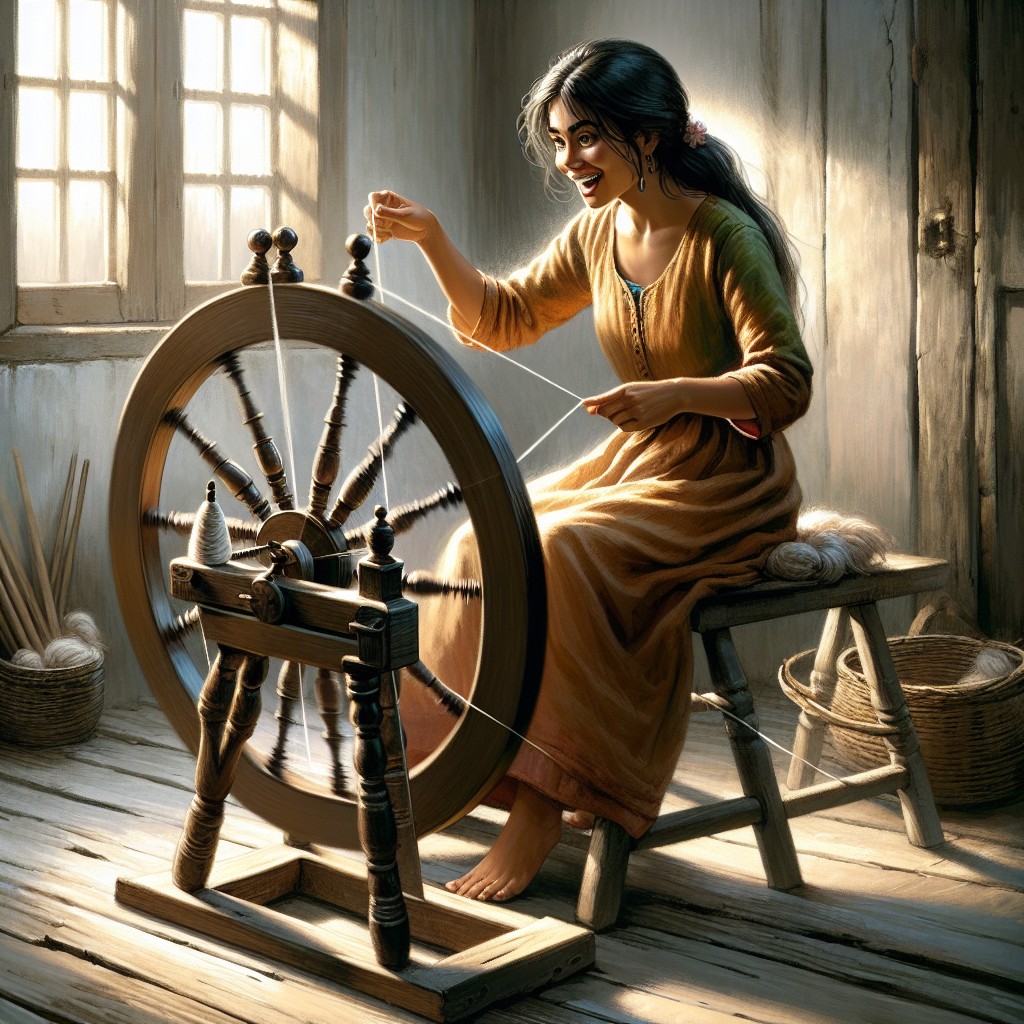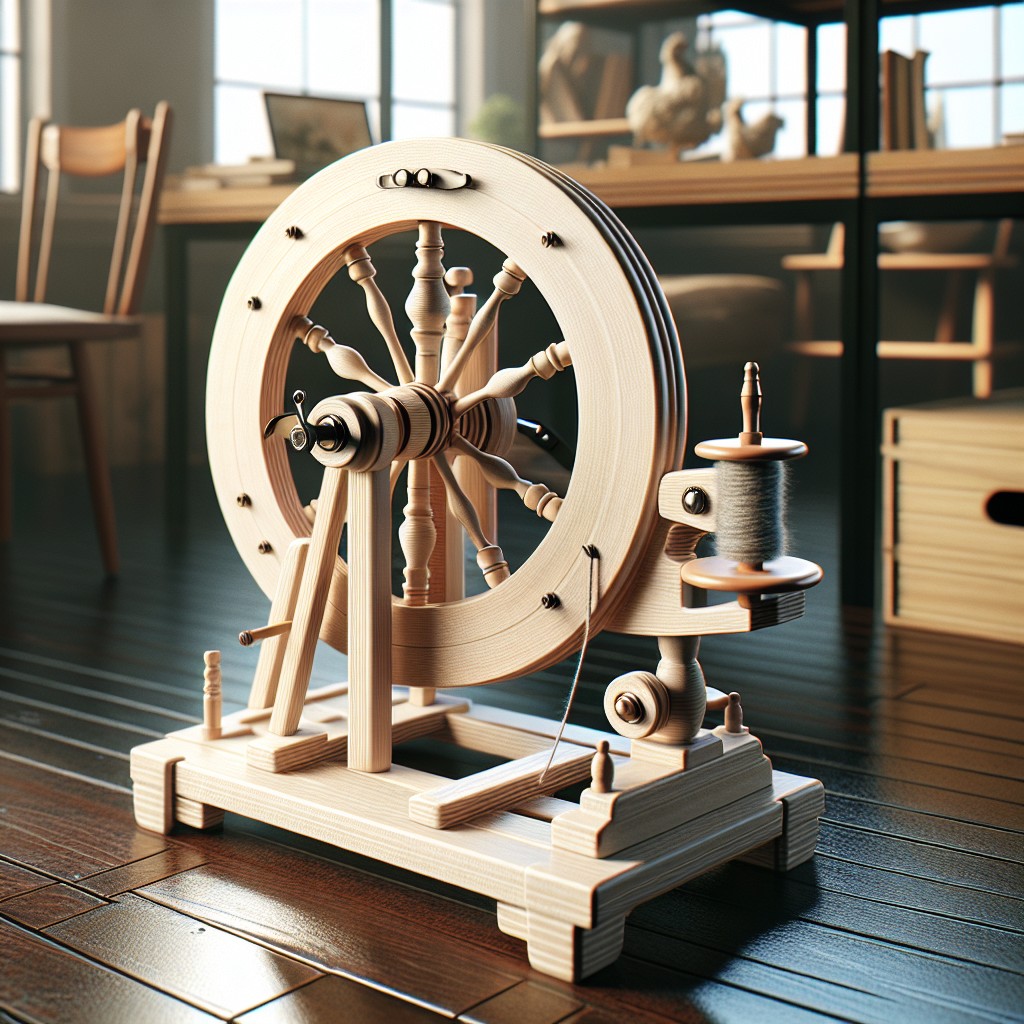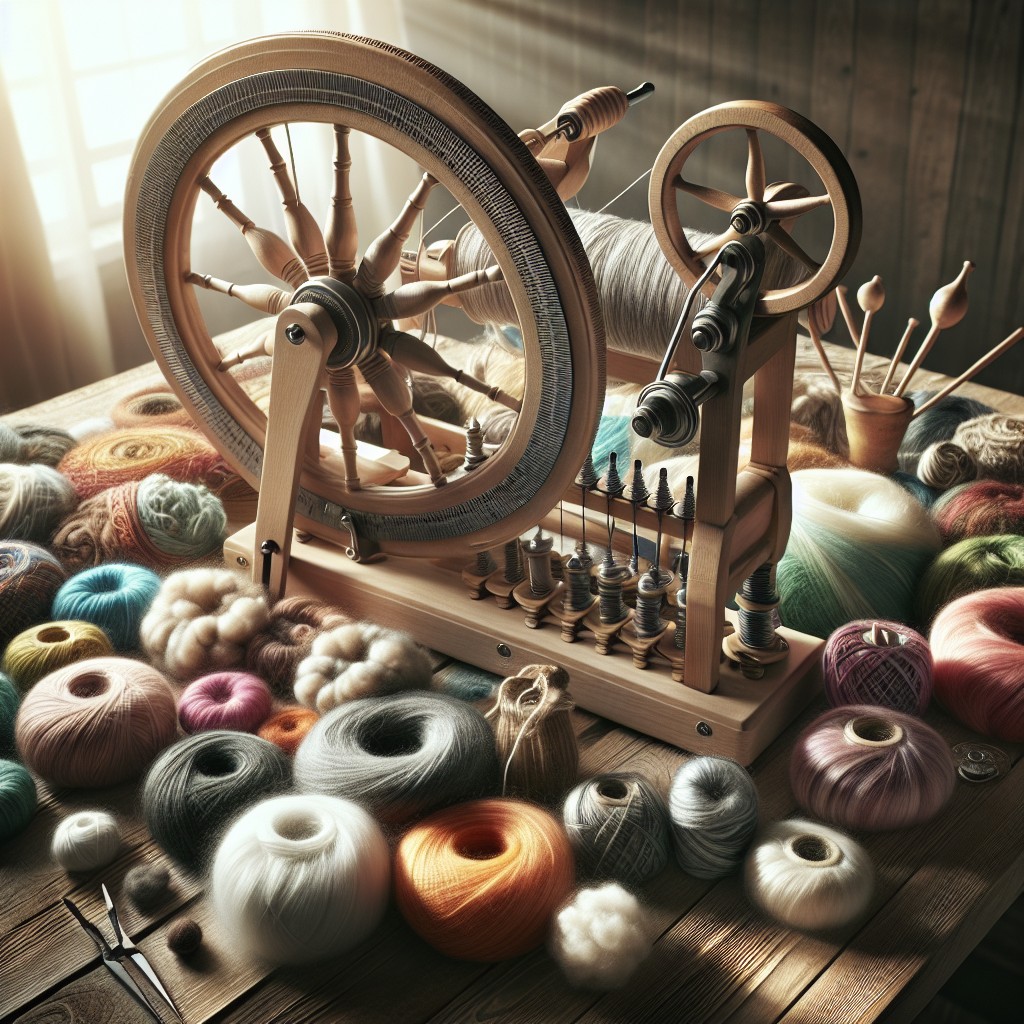Choosing the best spinning wheel for beginners may seem daunting, because understanding critical factors, features, and brands can significantly enhance your initial yarn crafting experience.
Key takeaways:
- Affordable spinning wheels for beginners are reasonably priced and good quality.
- Look for a versatile spinning wheel that can handle different yarn types.
- A spinning wheel with easy setup and simple tension systems is ideal for beginners.
- Consider a portable spinning wheel if you plan on attending workshops or knitting groups.
- Choose a spinning wheel that can be upgraded as your skills grow.
Great Beginner Spinning Wheels

When you’re just starting out, picking a spinning wheel that matches your skill level is essential. Consider these criteria:
- Affordability: Most learners prefer not to invest heavily until they’re more confident in their spinning abilities. A good beginner’s spinning wheel will be reasonably priced but still of solid quality.
- Versatility: Look for a wheel that can handle a variety of yarn types, from fine to bulky. This allows you to experiment with different fibers and techniques without being limited by your equipment.
- Ease of Use: A straightforward setup with simple tension systems and fewer adjustments prevents overwhelm and expedites the learning process.
- Portability: If you plan to attend workshops or knitting groups, a compact design will be your ally. Some wheels are designed to fold or come apart easily for transportation.
- Expandability: As skills grow, so might the need for advanced features. Choose a wheel that can grow with you, perhaps with additional bobbins or a range of ratios for different spinning speeds.
- Support and Resources: A beginner-friendly wheel is often accompanied by a community or resources that help you troubleshoot and improve—think online tutorials or a responsive customer service team.
The Real Purpose of Your First Spinning Wheel

Your initial spinning wheel plays a pivotal role in your fiber art journey – it’s your learning partner. Its purpose is not to spin every type of yarn imaginable, but to provide a comfortable and forgiving environment to develop your skills. Consider it akin to training wheels on a bicycle; it’s there to help you find your balance and rhythm in the craft.
Here are a few points to understand the concept:
- Simplicity: Beginner wheels often feature straightforward mechanics, making it easier to focus on the basics of drafting and twist without overwhelming you with options.
- Versatility: A good starter wheel should handle a range of fibers and yarn weights, offering a broad learning experience.
- Adjustability: Look for a wheel that allows for tension and speed modifications as this can accommodate your evolving skills.
- Durability: A well-built wheel can withstand the learning curve mishaps and serve you well as your spinning confidence grows.
It’s Affordable

For a newcomer to the craft, sticking to a budget is key. A good starter wheel shouldn’t break the bank, allowing you to test the waters without a significant financial commitment. Look for spinning wheels that offer a balance between quality and cost-effectiveness.
Price Range: Beginner spinning wheels can range from $200 to $500. Anything considerably below might compromise on quality.
Used Options: Consider purchasing a second-hand wheel to save money. Ensure it’s in good working order, as repairs can be costly.
Material: Starter wheels made from plywood or MDF are generally less expensive than those crafted from solid wood but still durable enough for learning.
Features vs. Cost: Decide on the features you absolutely need. Extras like aesthetic flourishes shouldn’t take precedence over functionality and cost.
Kit Options: Some wheels come unassembled as kits, which can be a more affordable option and also give you a chance to understand the construction of your spinning wheel.
Upgrade Potential: A wheel with options for later upgrades is a wise investment, allowing for enhancements as you grow more skilled without the need to purchase a new wheel.
Remember, the goal is to learn and enjoy spinning. An affordable wheel is a practical choice as you develop your skills and preferences.
It Can Spin “Most Things”

When selecting your first spinning wheel, versatility is key. Ideally, it should handle a range of fibers from delicate merino to sturdy hemp. Look for a wheel with adjustable tension and interchangeable bobbins or whorls, as these allow for the creation of different yarn weights, from lace to bulky. This not only broadens the spectrum of projects you can tackle but also provides a comprehensive learning experience, helping you understand tension and twist across various fiber types. A beginner’s wheel with these capabilities ensures that as your skills grow, your wheel will continue to meet your evolving crafting needs.
Types of Spinning Wheels
Understanding the architectural variances among spinning wheels aids beginners in selecting a model that aligns with their spatial constraints and ergonomic preferences.
Saxony wheels, characterized by their horizontal layout and fairy-tale appearance, typically feature a large wheel to one side, with the flyer and bobbin aligned on a horizontal bench. This design is renowned for its ease of use, making it a favored choice for those new to spinning.
Castle wheels boast a vertical configuration, with the flyer and wheel stacked to save space, ideal for crafters with limited room. Their compact nature doesn’t sacrifice functionality, and they can be quite beginner-friendly.
Modern spinning wheels diverge from traditional aesthetics, focusing instead on practicality and transportability. Often folding or partially disassembling for convenience, these wheels may feature innovative tension systems and materials, catering to the contemporary spinner seeking portability and versatile functionality.
Each type accommodates distinct preferences and lifestyles, ensuring newcomers to spinning can find a wheel that not only teaches foundational skills but also fits seamlessly into their crafting space.
Saxony Spinning Wheels
With their horizontal layout, Saxony spinning wheels evoke a classic fairy tale aesthetic that fascinates many beginners. These wheels feature a large, often ornately decorated wheel at one end, with the flyer and bobbins positioned horizontally in alignment. The traditional design is not just about looks; it provides a comfortable treadling experience, suitable for long spinning sessions.
The size of Saxony wheels can require a dedicated space in your home, so it’s essential to consider your available room. Their functionality is typically versatile, supporting various yarn types, which is invaluable when you’re exploring different spinning techniques. Additionally, the intuitive arrangement of the wheel and flyer helps new spinners understand the mechanics of yarn production.
When starting, tension control might seem daunting, but Saxony wheels generally offer straightforward systems. Whether it’s Scotch tension for delicate adjustments or Irish tension for stronger uptake, getting to grips with these can bolster your spinning proficiency.
As a con, the spread-out design means these wheels aren’t as portable as other types. However, if travel isn’t a priority and you’re drawn to the charm and potential of the Saxony wheel, it can serve as a rewarding first investment in your spinning journey.
Castle Spinning Wheels
Castle spinning wheels, known for their vertical alignment, occupy less floor space, making them a practical choice for crafters with limited room. The flyer and bobbins are positioned directly above the wheel, with the treadles below. This compact arrangement results in a more upright sitting position, which some spinners find more comfortable for long spinning sessions.
The vertical design also typically allows for more bobbins to be stored on board, making it easier to switch between projects. Additionally, castle wheels often feature a double-treadle system, providing a smoother and more balanced spinning experience. While they can be slightly more challenging to master due to the upward force required to treadle, their efficiency and space-saving attributes make them a top contender for beginners looking for a long-term investment in their crafting journey.
Modern Spinning Wheels
Modern spinning wheels offer a contemporary take on the traditional craft of yarn spinning. Often compact and lightweight, these wheels typically feature innovative design elements that cater to convenience and ease of use, which are especially beneficial for beginners.
With modern spinning wheels, one can enjoy features such as:
- Portability: Many can be easily disassembled and transported, making them ideal for those with limited space or who like to take their crafting on the go.
- Versatility: They often come with options to add various attachments and accessories, allowing spinners to explore different yarn types and techniques.
- Simple Maintenance: Designed with fewer moving parts, modern wheels are usually easier to maintain and keep in working order.
- Integrated Technology: Some models include electronic assists like e-spinners, which take the physical strain out of spinning and ensure a consistent yarn thickness.
These characteristics make modern spinning wheels a perfect gateway for novices eager to dive into the world of spinning without being overwhelmed by the more complex adjustments and mechanics of traditional wheels.
Components of Spinning Wheels
Understanding the individual elements of a spinning wheel helps beginners make informed choices.
Flyer: This part twists the fibers as they are spun, and it also winds the newly created yarn onto the bobbin.
Bobbin: Holds the yarn that you’ve spun. Multiple bobbins are useful for creating plied yarns.
Treadles: Pedal-like parts that the spinner operates with their feet, initiating the spinning motion. A double treadle can offer a more balanced, comfortable experience, especially for extended spinning sessions.
Drive Band: A cord that connects the wheel to the flyer, transferring the motion.
Mother-of-All: The part that holds the flyer and bobbin and allows tension adjustments, having a significant impact on yarn consistency.
Orifice: The small hole through which you feed fiber onto the bobbin; its size influences the thickness of yarn you can spin.
Maidens: The upright pieces that support the flyer and bobbin assembly. They play a key role in how smoothly the wheel spins.
Each component comes in various styles and capacities, shaping the spinning wheel’s overall functionality and user-friendliness.
Choosing an E-Spinner
Electric spinners, often referred to as e-spinners, offer a compact and portable option for beginners. Without the need for treadling, these devices cater to those who might have knee problems or prefer a hands-focused spinning process.
When selecting an e-spinner, keep the following points in mind:
- Power Source: E-spinners typically require electricity, so consider battery-operated models if you plan to spin on the go.
- Foot Pedals: Some e-spinners come with foot pedals, giving you the option to control the speed hands-free, much like a traditional wheel.
- Noise Level: These machines can vary in noise output. Test them out or read reviews to find one that operates quietly, ensuring a more pleasant spinning experience.
- Ergonomics: The design should be comfortable for extended use, with easy-to-reach controls and a smooth spinning action.
- Versatility: Look for an e-spinner that can handle various types of yarn, as this will allow you to explore different spinning techniques and fibers.
Remember, the best e-spinner for you is one that fits your specific needs and spinning ambitions.
FAQ
What is the easiest spinning wheel for beginners?
The easiest spinning wheel for beginners is generally an e-spinner due to its high functionality and responsiveness.
How do I choose a spinning wheel?
When choosing a spinning wheel, opt for one that offers a good range of 3 or more ratios as standard, with options to add slower or faster whorls for double drive wheels or different flyers for single drive wheels to provide additional needed ratios.
What is the easiest fiber to spin for beginners?
The easiest fiber for beginners to spin is carded wool.
What essential features should beginners look for in a spinning wheel?
Beginners should look for a spinning wheel that is easy to use, has adjustable speed controls, offers optional extras like additional bobbins or a distaff, and falls within their budget.
What are some common mistakes to avoid when operating a spinning wheel for the first time?
Common mistakes to avoid when operating a spinning wheel for the first time include over-twisting the yarn, treadling against the wheel’s momentum, and unevenly feeding the fiber.
Can you recommend any effective spinning wheel maintenance tips for beginners?
Regular cleaning, lubricating moving parts, replacing worn out pieces, and ensuring consistent tension are essential steps for effective spinning wheel maintenance.
Related Stories
- Scotch Tension Spinning Wheel: An Informational Guide
- How to Make a Spinning Wheel for Yarn: A Comprehensive Guide
- How to Use a Spinning Wheel: Comprehensive Instruction Guide
- Thread Spinning Wheel: A Comprehensive Guide to Different Types and Specifications
- Yarn Making Tools: Comprehensive Guide for Perfect Crafting
